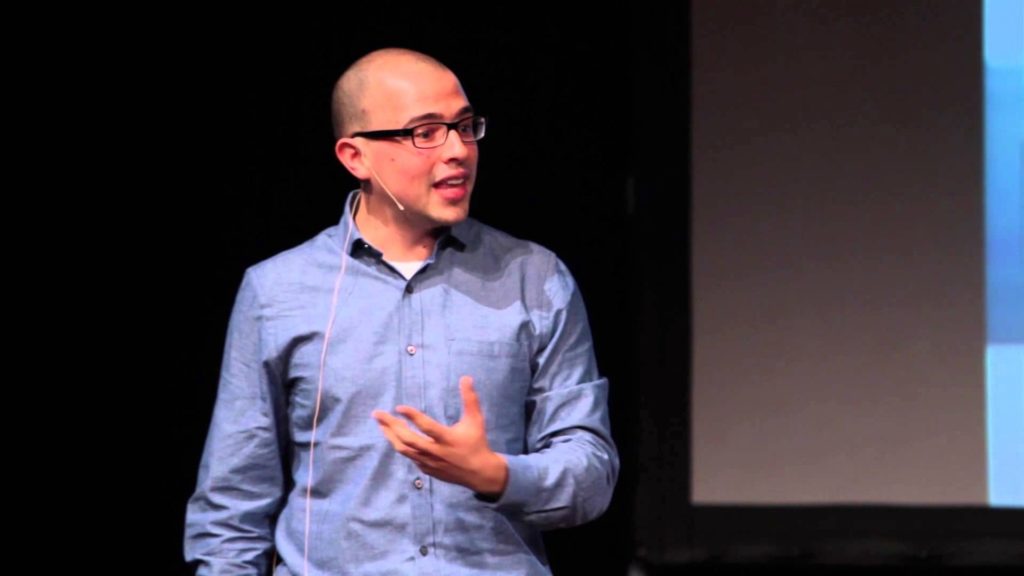
5 Techniques to speak any languages หรือ 5 เทคนิคที่ช่วยให้เราสามารถเรียนรู้และพูดได้ทุกภาษา จากคนที่ทำสำเร็จได้จริงๆ อย่าง Sid Efromovich วิธีการของเขาน่าจะมีประโยชน์สำหรับคนไทย โดยเฉพาะกลุ่มคนทำงาน
เพราะปัญหาเรื่องภาษา โดยเฉพาะภาษาอังกฤษ ถือว่าเป็นอุปสรรคอย่างนึงที่ทำให้คนทำงานหลายคน ไม่สามารถเข้าถึงโอกาสที่มากกว่าเดิม หรือ ดีกว่าเดิมได้ โดยเฉพาะในปัจจุบันที่ชีวิตเต็มไปด้วยการแข่งขัน ภาษาเป็น 1 ในคุณสมบัติที่คนมากมายต้องการร่วมงานด้วย ยิ่งพูดได้ดี พูดได้หลากหลาย ยิ่งได้เปรียบ ไม่ใช่แค่เรื่องตัวเลือกในการทำงาน แต่หมายถึงจำนวนเงินที่ได้รับการเสนอให้ด้วย
เคยได้ยินหลายคน ชอบพูดกันว่าภาษาเป็นกำแพงในการสื่อสาร แต่จริงๆแล้ว มันคือสะพานแห่งการเรียนรู้ต่างหาก บางคนเลือกที่จะโยนมันทิ้งไปเลย เพราะถือว่าเกิดมาพูดภาษาบ้านเกิดตัวเองได้ แค่นั้นก็คงจะพอแล้ว แต่พวกเขาอาจจะลืมไปว่า โลกยุคนี้ไม่มีพรมแดนอีกต่อไปแล้ว หากเรามีความรู้ทางด้านภาษามากกว่าภาษาของประเทศเรา
แต่เอาเข้าจริง จะเอาแคภาษาที่สองยังยากเลย คงไม่ต้องพูดถึงภาษาที่ 3, 4 หรือ อื่นๆ เพราะหากพวกเรายังก้าวข้ามภาษาที่ 2 ยังไม่ได้ มันก็คงจะไปเรียนรู้ภาษาถัดไปยากเข้าไปอีก หรือ ที่เราก้าวข้ามอุปสรรคเรื่องภาษาไม่ได้ อาจจะเป็นเพราะวิธีการเรียนของเราอาจจะไม่เหมาะ หรือ ไม่มีประสิทธิภาพหรือเปล่า?
เอาเป็นว่า ตอนนี้ เราลองมาเริ่มกันใหม่ ลองมาทำความเข้าใจวิธีการของคนที่เขาทำสำเร็จแล้ว และเป็นคนที่พูดได้หลายภาษากันดีกว่า ว่าเขามีวิธีการอย่างไร?
Sid Efromovich เติบโตมาในสิ่งแวดล้อมที่มีผู้คนใช้ภาษาอย่างหลากหลาย เขาพูดได้ 4 ภาษาในตอนที่เขาอายุได้แค่ 18 ปี และหลังจากนั้น 3 ปี เขาพูดได้อีก 3 ภาษา คนรุมถามเคล็ดลับการเรียนรู้ภาษาของเขาบ่อยๆ พอๆกับการถามเบอร์โทรศัพท์ของเขาเลย
ประเด็นอยู่ที่เขาทำมันได้อย่างไร?

“การเรียนรู้ภาษาของผมไม่เหมือนคนอื่น”
เขาเล่าว่า สำหรับคนอื่นการเรียนภาษาเหมือนเป็นเรื่องเครียด ต้องใช้ความพยายามอย่างมาก ทำให้ยากเกินจะเข้าใจ และมันก็เป็นสิ่งที่เป็นไปไม่ได้สำหรับใครหลายคน แต่เรื่องนี้เขามองแตกต่างจากคนทั่วไปอย่างสิ้นเชิง สำหรับเขาเขามองว่าการเรียนภาษาเป็นเรื่องที่เพลิดเพลินมาก มันสนุก น่าตื่นเต้น และเขาก็ชอบมันในทุกช่วงเวลาที่ได้เรียนรู้
ในการบรรยายของเขาใน TEDxUpperEastSide เขาได้แชร์ 5 เทคนิคในการพูดภาษาต่างๆ ซึ่งเทคนิคเหล่านี้ มันจะทำให้การเรียนรู้เรื่องภาษากลายเป็นเรื่องง่ายไปเลย และ หลังจากที่เราได้เรียนรู้เทคนิคเหล่านี้ เราอาจจะรักการเรียนภาษาอย่างที่ Sid Efromovich รักมันมาตลอดได้เช่นกัน
1. กล้าจะผิด กล้าที่จะสร้างข้อผิดพลาด
ในการจะทำเทคนิคข้อที่ 1 ให้ได้นั้น เราต้องสูดลมหายใจเข้าลึกๆ และโยนสิ่งที่เราเคยถูกปลูกฝังมาทิ้งไปก่อน เพราะเรามักถูกกำหนด ถูกตีกรอบเสมอว่าทำอะไรได้ ทำอะไรไม่ได้ ต้องทำในสิ่งที่ถูกต้องเสมอ แต่กฎหลักของการเรียนภาษาก็คือ เราต้องกล้าที่จะทำผิด และต้องสามารถเรียนรู้จากข้อผิดพลาดนั้นได้
“ไม่มีอะไรในขอบเขตความรู้ของเรา ที่จะบอกเราได้ว่าเรากำลังทำสิ่งที่ถูก”
ฐานข้อมูลภาษาทุกภาษา เกิดจากการนำโครงสร้างรวมกับการออกเสียง ซึ่งบ่อยครั้งที่เราต้องเจอกับโครงสร้าง หรือ การออกเสียง ที่เกินกว่าฐานข้อมูลที่เรียนมา เพราะฉะนั้นหากจะกำหนดการเรียนรู้อยู่แค่ภายในฐานข้อมูลภาษา เราจะไม่มีวันประสบความสำเร็จในการเรียนภาษาได้เลย
“เมื่อเราพูดมันออกมาอย่างเพอร์เฟ็กต์ แต่กลับคิดว่ามันยังมีข้อผิดพลาด จงจำความรู้สึกนั้นไว้”
ความรู้สึกตื่นกลัว ความรู้สึกไม่ปลอดภัย หรือความรู้อับอายเมื่อเราทำบางอย่างผิดพลาด ความรู้สึกนั้นแหละที่จะสามารถกระตุ้นเราได้ มันเป็นสัญญาณ ที่แสดงว่าเรากำลังก้าวออกจากกรอบฐานข้อมูลภาษาเดิมของเรา เรากำลังก้าวสู่ดินแดนใหม่ เราต้องแก้ไขความเข้าใจเดิม ให้เป็นสิ่งใหม่ที่ถูกต้องเข้าไปแทนที่
“เราต้องอนุญาตตัวเอง ให้กล้าที่ฝ่าฝืนสิ่งเดิมๆ กรอบเดิม ของฐานข้อมูลภาษาออกไป”
จากการเรียนรู้ภาษา ไม่ว่าจะเป็นการท่องจำหรือทำความเข้าใจ เราจะต้องกล้าที่จะยอมรับในความแปลกใหม่ หรือสิ่งใหม่ๆ นอกเหนือจากสิ่งที่เราเคยเรียนรู้มาก่อน ยกตัวอย่างเช่นคำว่า Puerta เป็นภาษาสเปนที่แปลว่าประตู แน่นอนว่าถ้าเราเรียนภาษาอังกฤษมา เราจะออกเสียง Pu, e และ ta ได้แน่นอน แต่ถ้าเรายังยึดความรู้เดิมอย่าง r จากภาษาอังกฤษละก็ เราก็จะออกเสียงคำนี้ผิดทันที เพราะ r ตัวนี้ในภาษาสเปนจะต้องกระดกลิ้นและออกเสียงคล้ายกับ rr ต่างหาก
2. ทิ้งพยัญชนะภาษาที่จะเรียนไปก่อน
เป็นเรื่องยากที่จะเรียนการพูดภาษาต่างๆ เมื่อพยัญชนะของแต่ละภาษาต่างกัน ยิ่งบางภาษาเขียนเหมือนกัน แต่กลับออกเสียงไปคนละทิศ คนละทางแบบที่เราคาดไม่ถึงเลย เพราะฉะนั้นในเทคนิคที่ 2 นี้ คือการโยนพยัญชนะเหล่านั้นทิ้งไปก่อน ให้เราเขียนกำกับการออกเสียงด้วยภาษาที่เรารู้ไปก่อน ตัวอย่างเช่น หากเราเรียนภาษาอังกฤษ เราก็เขียนกำกับการออกเสียงเป็นภาษาไทยไปก่อน ตามตัวอย่างข้างล่างนี้
- Tiger = ไทเกอะ
- Passion = แพชเชิน
- Black = แบล็ค
- Business = บิซซิเนส
อย่างน้อยในตอนที่เราเรียนภาษาอังกฤษ เรายังสามารถออกเสียงคำเหล่านี้ได้ โดยไม่สับสนกับการทำความเข้าใจว่าพยัญชนะแต่ละตัวว่าต้องออกเสียงแบบไหนกันแน่ เมื่อเราเริ่มกำกับเหล่าคำที่ไม่แน่ใจในการออกเสียง ด้วยการเขียนกำกับการออกเสียงในแบบที่เราสามารถเข้าใจได้ แปลว่าเรากำลังก้าวเข้าสู่การเรียนรู้ภาษาในรูปแบบที่ไม่คุ้นเคยได้เรียบร้อยแล้ว ซึ่งหมายความว่า เราได้พังกำแพงฐานข้อมูลเดิมของเราออกมาแล้ว
3. ตรวจสอบข้อผิดพลาดจากสิ่งจูงใจ
สิ่งจูงใจที่เราต้องหาในที่นี่ ไม่ได้หมายถึงคนรัก เงิน หรือชื่อเสียง แต่หมายถึงใครสักคนที่คเราสบายใจในการจะหัดพูดกับเขา คุยกับเขาด้วยภาษาที่เรากำลังเรียนรู้ เชื่อใจเขา และเขาสามารถแก้ไขข้อผิดพลาดให้เราได้เมื่อเราทำผิด โดยที่ทั้งสองฝ่ายจะต้องไม่เกิดอารมณ์เบื่อหน่าย อับอาย หรือไม่พอใจต่อกันและกัน ซึ่งจะดีมากถ้าคนคนนั้นจะเป็นคนที่ชักชวนให้คุณออกนอกกรอบการเรียนรู้ของคุณตั้งแต่แรก เช่น ครูที่โรงเรียน ติวเตอร์สอนพิเศษ เพื่อน หรือพ่อแม่ เป็นต้น
“ภาษา มันมากกว่าความสัมพันธ์ แต่เป็นการเรียนรู้จากกันและกัน”
4. บทสนทนาตอนอาบน้ำ
หลายคนเลยที่บอกว่าเวลาอาบน้ำเป็นเวลาคอนเสิร์ต เวลาซ้อมเต้น เล่นมิวสิควิดีโอ หรือบางคนก็บอกว่ามันคือห้องซ้อมร้องเพลง ในเทคนิคข้อที่ 4 นี้ เราต้องลองเปลี่ยนห้องน้ำเป็นสถานการณ์พูดคุยกับใครบางคน ซึ่งนั่นก็คือ กับตัวเราเองนั่นแหละ
เรื่องนี้อาจจะฟังดูตลก แต่ได้ผลแน่นอน เพราะปกติแล้วเวลาเราซ้อมพูดกับใคร เรามักจะเป็นฝ่ายถาม ไม่ก็ฝ่ายตอบอย่างเดียว แต่ถ้าเราได้ถามเอง ตอบเอง มันจะทำให้เราได้ฝึกทั้งฝั่งถามและตอบไปด้วยในเวลาเดียวกันเลย
“มันได้ผลสำหรับเขา สำหรับผม และ มันจะได้ผลกับคุณ”
สำหรับเรื่องนี้ มันอาจจะฟังดูเป็นเรื่องเล่าที่น่าอายที่เราคุยกับตัวเองในห้องน้ำ แต่ Michael Phelps นักกีฬาว่ายน้ำชาวอเมริกันที่ได้รับการยกย่องว่าเป็นนักกีฬาว่ายน้ำที่เก่งที่สุดในประวัติศาสตร์ก็ยังเคยทำแบบนี้ เขาเล่าว่า เขามักจะนึกภาพตัวเองตอนแข่งวนไปวนมาหลายครั้งก่อนที่เขาจะกระโดดลงไปในน้ำเสมอ มันเหมือนกับเขาได้ฝึกซ้อมว่ายน้ำด้วยภาพในหัวของเขาไปแล้ว และใช่ วิธีการนี้มันได้ผลจริงๆ
5. สูตรต้องมีเพื่อน (Buddy Formula)
ในเมื่อเราผ่านการฝึกฝนมาขนาดนี้แล้ว และได้ใช้เทคนิคไปแล้วทั้ง 4 ข้อ ตอนนี้ก็ถึงเวลาสำหรับเทคนิคข้อที่ 5 แล้ว นั้นก็คือ การใช้จริง ซึ่งสูตรต้องมีเพื่อน ที่พูดถึงก็คือ การหาใครสักคนมาคอยโต้ตอบ พูดคุยกับเราในภาษาที่เรากำลังเรียนรู้อยู่ แต่ขั้นตอนนี้จะต่างจากเทคนิคในข้อที่ 3 เพราะนี่คือการนำไปใช้จริง และจะพูดกับเพื่อนเฉพาะภาษาที่เราเรียนรู้อยู่เท่านั้น
“คู่สนทนาของเรา ควรมีความเชี่ยวชาญและสามารพูดภาษาที่เรากำลังเรียนรู้ได้อย่างสบายๆ”
การสนทนาให้เกิดประสิทธิภาพก็คือ เมื่อเราพบกับจุดนอกขอบเขตฐานความรู้เรา เราจะไม่กลับไปใช้ภาษาเดิมที่เราถนัด แต่เราจะใช้ภาษาที่กำลังเรียนรู้อยู่ในการพยายามอธิบายต่อไป เพราะฉะนั้นในการเลือกใครสักคนมาเป็นคู่สนทนาควรเลือกคนที่มีความถนัดในภาษาที่เรากำลังเรียนอยู่จริงๆ และเขาพร้อมที่สื่อสารกับเราในภาษานั้น เพราะมีเปอร์เซ็นต์สูงมากที่พวกเราจะกลับไปพูดภาษาเดิมกัน เมื่อเราทั้งคู่ไม่รู้ว่าควรจะสื่อสารอย่างไรในภาษาที่กำลังเรียนรู้กันอยู่
เมื่อเราเดินทางมาครบทั้ง 5 เทคนิคแล้ว เราจะพบกับสถานที่ที่สวยงามซึ่ง จะพบว่าการเรียนภาษาไม่ได้เป็นสิ่งที่เครียด หรือ ยาก หรือน่าเบื่ออีกต่อไป แต่มันคือเรื่องที่เป็นไปได้
และจะทำให้โลกของเราใบใหม่เปิดกว้างมากขึ้น เป็นโลกที่เราจะได้รับโอกาสในการสำรวจวัฒนธรรมใหม่และวิถีชีวิตความเป็นอยู่ที่แตกต่าง โอกาสใหม่ๆ มีให้เราไปค้นหา
รางวัลที่ดีที่สุดในการเรียนรู้ ไม่ใช่จำนวนภาษาที่เราพูดได้ แต่เป็นการที่เราได้เรียนรู้ตัวเองมากขึ้นจากการได้เรียนภาษาต่างหาก
บทสรุป
การเรียนรู้ภาษามันเป็นเรื่องยากก็เพราะเราคิดว่ามันยาก จากเทคนิคทั้ง 5 ข้อ ที่ Sid Efromovich ให้เรามานั้น ไม่มีอะไรที่ยากเกินความสามารถของพวกเราเลย
ต่อให้เราจะเป็นเด็กมัธยมศึกษา หรือ เตรียมเรียนมหาวิทยาลัย หรือ เป็นนักศึกษาเตรียมตัวสู่การทำงาน หรือ อาจจะกำลังทำงานอย่างหนักในแต่วัน หากเราได้ลองจัดสรรเวลาให้ดี แล้วเพิ่มเทคนิคทั้ง 5 ข้อนี้ แอดมินคิดว่าว่ามันให้ผลลัพธ์ที่คุ้มค่ากับพวกเราอย่างแน่นอน
“ในตอนนี้มันอาจจะฟังดูยาก แต่มันไม่ได้หมายความว่ามันยากจนไม่สามารถทำได้ การเดินทางไกลต้องเริ่มต้นจากก้าวแรกเสมอ และมันจะไม่ใช่ปัญหาเลย เมื่อเรารู้วิธีเดินอยู่แล้ว”
Sid Efromovich
…..





